RDA: Resource description and access part 1 - Joint Steering ...
RDA: Resource description and access part 1 - Joint Steering ...
RDA: Resource description and access part 1 - Joint Steering ...
- No tags were found...
You also want an ePaper? Increase the reach of your titles
YUMPU automatically turns print PDFs into web optimized ePapers that Google loves.
5JSC/<strong>RDA</strong>/Part I/CILIP response5JSC/<strong>RDA</strong>/Part I/Chapter 3/CILIP response20 March 2005p. 62.3.0.2 (c), 2.3.2.2: Presumably <strong>RDA</strong> is written to cover the case of a parallel title printed at thetop of each page but omitted from the title-page of a multi-paged textual work, or where the title<strong>and</strong> parallel titles appear on the cover of a work with no title page, or one with two title pages ineach of two languages. The rule should st<strong>and</strong> if, generally, it is important to record parallel titlesas <strong>part</strong> of the title attribute. If it is not that important, then why not restrict taking the parallel titlefrom the source of information for the title proper? If it is not on the source of information of thetitle proper might it be confusing to record it as <strong>part</strong> of the title, <strong>and</strong> would it be better given an<strong>access</strong> point <strong>and</strong> a note as a variant title?2.3.5.1: This is clear, but extremely condensed. Whilst condensation in a definition is generally avirtue, it would be helpful to make some relation of these definitions to why earlier titles applyonly to integrating resources <strong>and</strong> later titles only to resources issued in successive <strong>part</strong>s. Perhapsall that is required here is a reference to 2.1.1.1 in the definition of "later title" <strong>and</strong> to 2.1.1.2 inthe definition of "earlier title", e.g.Earlier titles apply in describing integrating resources because the <strong>description</strong> is basedon current iteration of a resource (see 2.1.1.2)Later titles apply in describing resources issued in successive <strong>part</strong>s because the<strong>description</strong> is based on the first/earliest issue/<strong>part</strong> (see 2.1.1.1)It is unfortunate that because of the way the rules have to be structured the definition forintegrating resources must come first, when it would be more natural (for most user) for thedefinition of titles applying to integrating resources to come second.2.3.8.4, 2 nd para.: If the corrected form of the title is considered important for <strong>access</strong>, CILIP doesnot see how providing an <strong>access</strong> point can be optional. Provision of an <strong>access</strong> point need notpreclude a note. It would be better to treat the identification <strong>and</strong> <strong>access</strong> requirements separately.So, if the corrected title is significant for <strong>access</strong>, then an <strong>access</strong> point should be required (but thenote could be optional); if significant for identification, then a note should be required (but the<strong>access</strong> point could be optional).2.4.0.5: In the option to truncate a single statement of responsibility that names more than threepersons, etc., CILIP would like to suggest either retaining the instruction from AACR2 1.1F5 toadd et. al. in square brackets, or (our preferred choice) summarising the extent of the omission inthe language of the cataloguing agency, e.g.:... [<strong>and</strong> 3 others]This is especially important for early printed books to note the nature of the omission, as inDCRB the mark of omission without [et al.] is used in statements of responsibility to indicateomission of academic or clerical affiliations, academic degrees, etc. following the author's nameon the title page.2.4.0.7: CILIP also recommends an additional provision for early printed books.2.4.3.3 (referred to at 2.4.0.3): This rule is effectively a reversal of AACR2 12.1F3, <strong>and</strong> is likelyto be most easily applied retrospectively. Dealing with live serials requires a prospectivejudgement to be made – one which obviously may well turn out to be wrong. The rule risksappearing as though it only applies to serials you may retrospectively examine once they haveceased. While the problem isn't frequently encountered, the variance in practice is plain to see(e.g. Millers' price guides to antiques).


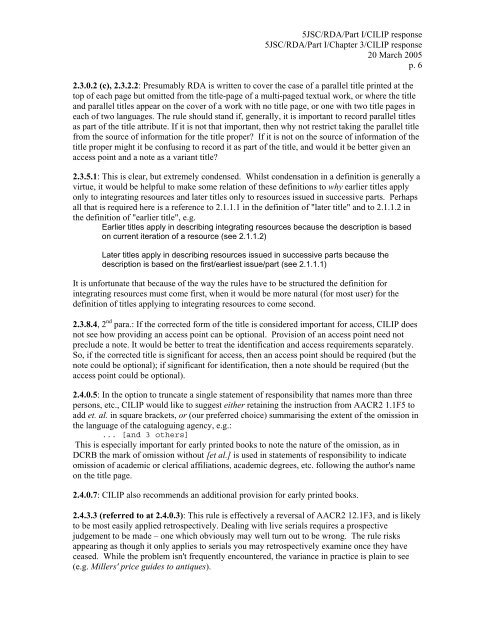

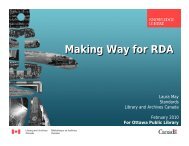
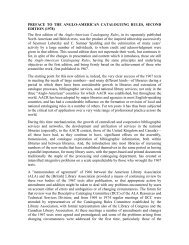
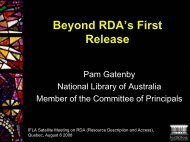



![Presentation slides [PDF] - Joint Steering Committee for ...](https://img.yumpu.com/41621230/1/190x143/presentation-slides-pdf-joint-steering-committee-for-.jpg?quality=85)

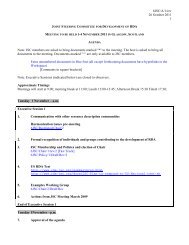
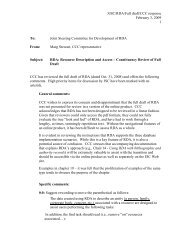
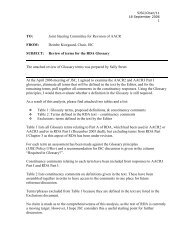
![Presentation slides [PDF] - Joint Steering Committee for ...](https://img.yumpu.com/35256207/1/190x143/presentation-slides-pdf-joint-steering-committee-for-.jpg?quality=85)
